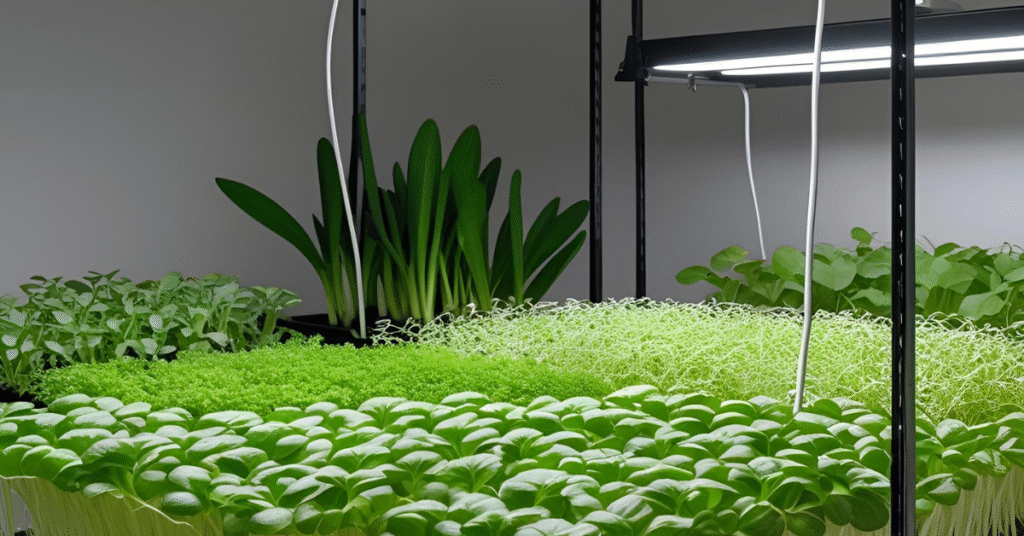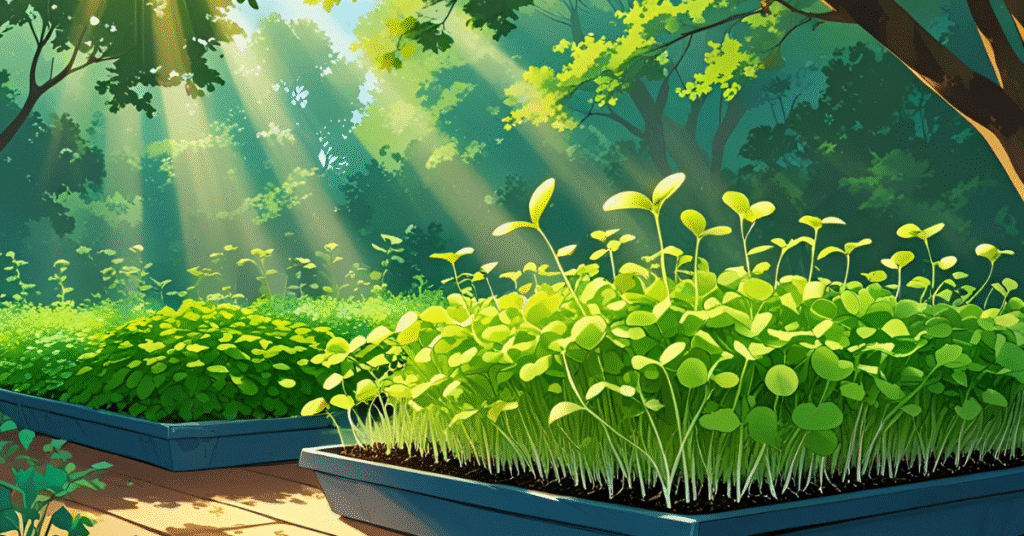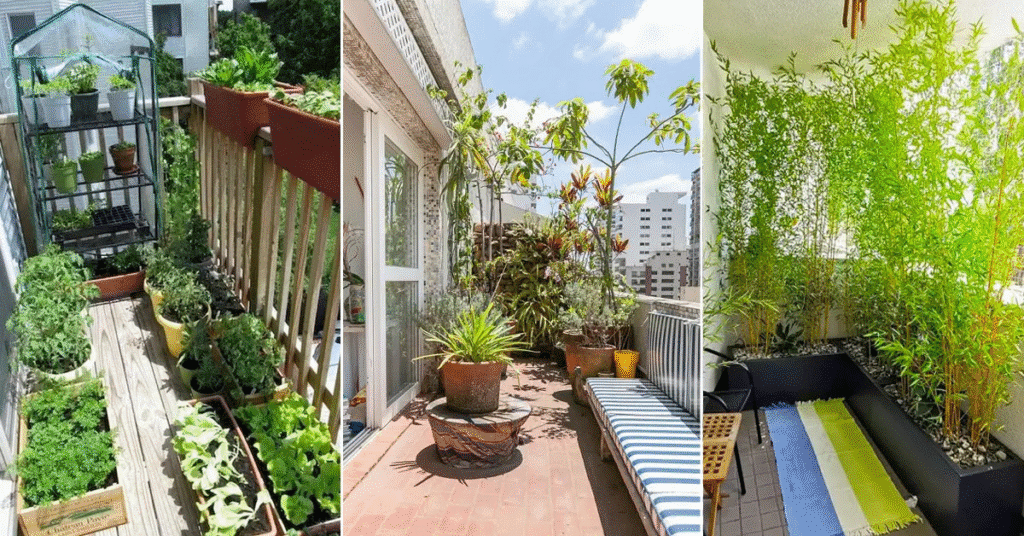Starting an urban garden is exciting, but it’s easy to make costly mistakes that can derail your green thumb dreams. Whether you’re working with a tiny balcony, rooftop space, or indoor setup, understanding the common mistakes new urban gardeners make can save you time, money, and frustration.
Urban gardening presents unique challenges compared to traditional backyard gardening. Limited space, container constraints, and environmental factors create specific pitfalls that catch beginners off guard. The good news? Most of these mistakes are completely avoidable once you know what to watch out for.
Quick Reality Check
About 73% of new urban gardeners abandon their projects within the first year, often due to preventable mistakes. This guide covers the top 15 errors and provides practical solutions to keep your garden thriving.
1. Starting Without Proper Planning
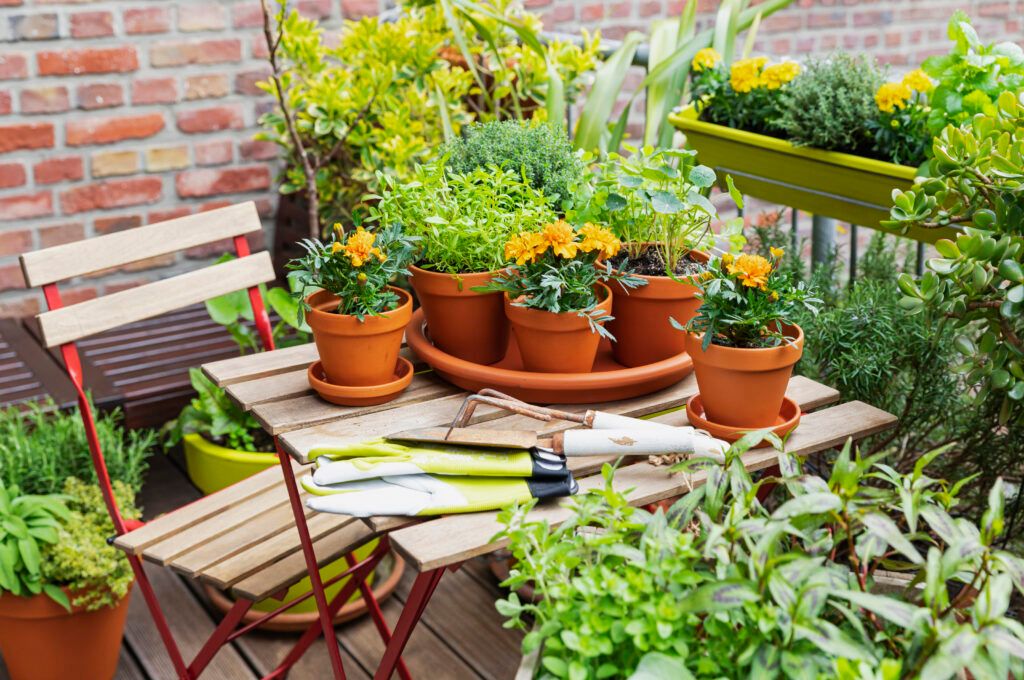
The biggest mistake new urban gardeners make is rushing to the garden center without a clear plan. This impulse leads to buying unsuitable plants, wrong-sized containers, and incompatible growing combinations.
Why This Happens
- Excitement to get started immediately
- Lack of understanding about space limitations
- Impulse purchases at garden centers
- Not considering seasonal timing
The Solution
Before buying anything, assess your space thoroughly:
- Measure available space and note sun exposure patterns
- Research plants suitable for your climate zone
- Create a simple garden layout sketch
- Start with 3-5 easy plants rather than trying everything at once
2. Using Containers That Are Too Small
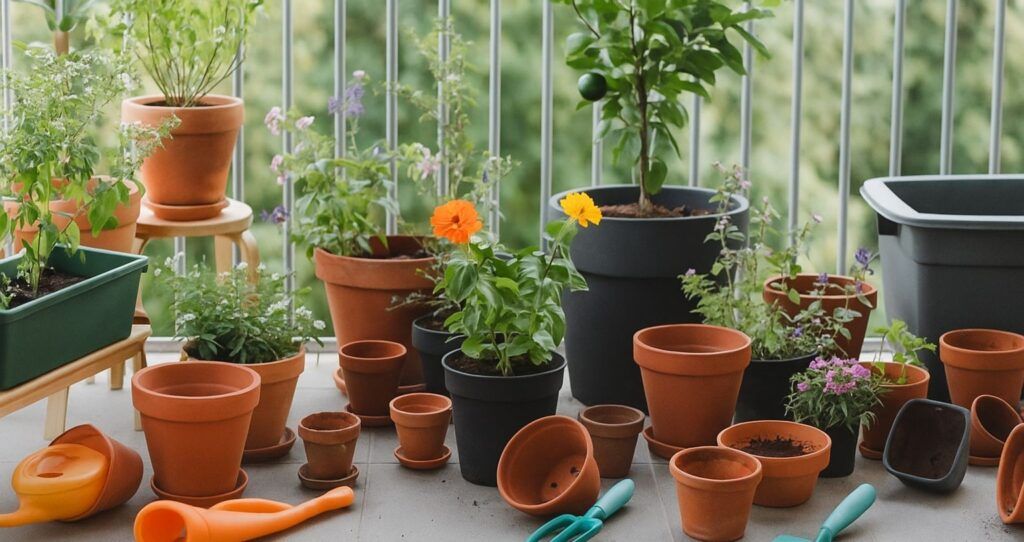
One of the most common mistakes new urban gardeners make is underestimating container size needs. Small pots might look cute, but they create a host of problems that doom plants to failure.
Problems with Small Containers
- Root binding: Plants become stunted when roots have nowhere to grow
- Rapid water loss: Small containers dry out quickly, requiring constant watering
- Temperature fluctuations: Limited soil volume can’t buffer temperature changes
- Nutrient depletion: Less soil means fewer available nutrients
Container Size Guidelines
Herbs: Minimum 6-8 inches deep
Leafy greens: 8-10 inches deep
Root vegetables: 12+ inches deep
Tomatoes: 20+ gallon containers
Peppers: 10-15 gallon containers
Fruit trees: 25+ gallon containers
3. Improper Watering Techniques
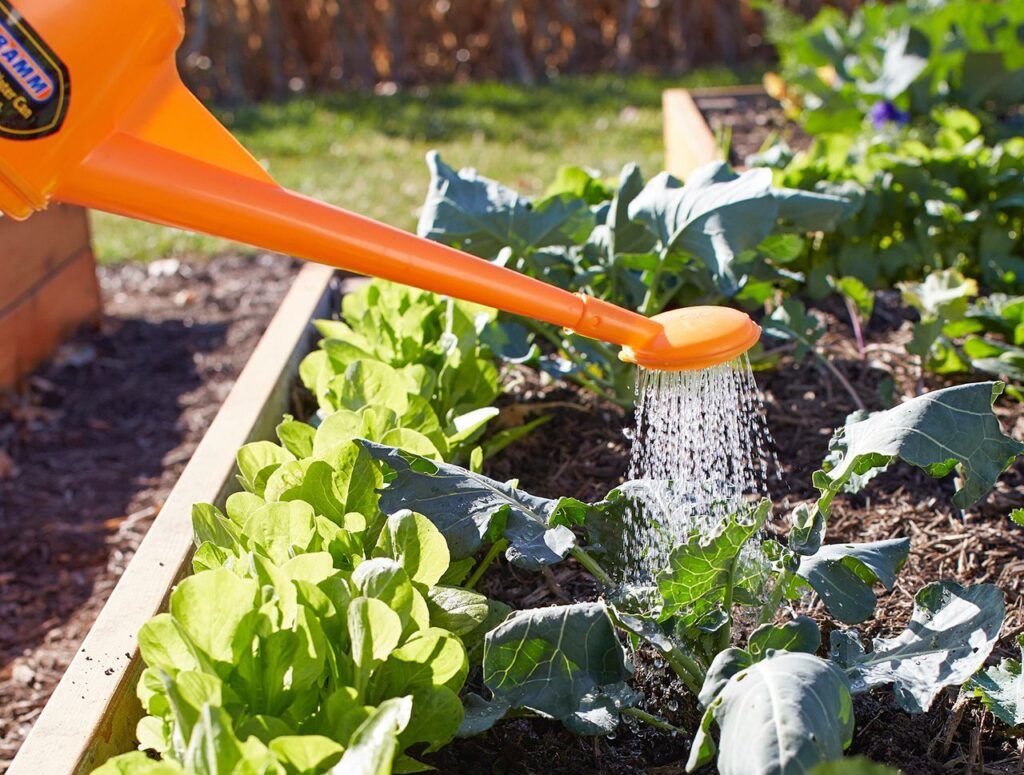
Watering seems straightforward, but it’s one of the areas where new urban gardeners make critical errors. Both overwatering and underwatering can quickly kill plants, and container gardens have unique watering needs.
Common Watering Mistakes
- Overwatering: Leading cause of plant death in containers
- Inconsistent scheduling: Sporadic watering stresses plants
- Watering leaves instead of soil: Promotes disease and wastes water
- Wrong timing: Watering during hot midday sun can burn plants
Proper Watering Strategy
- Check soil moisture: Stick your finger 1-2 inches deep
- Water early morning: Best time is 6-10 AM
- Water deeply but less frequently: Encourages deep root growth
- Ensure proper drainage: Containers need drainage holes
- Use consistent schedule: Plants thrive on routine
4. Ignoring Light Requirements
Many new urban gardeners don’t realize that different plants have vastly different light needs. Placing sun-loving tomatoes in a shady corner or shade-preferring lettuce in blazing afternoon sun sets up your garden for failure.
Understanding Light Categories
Full Sun (6+ hours)
Tomatoes, peppers, squash, most herbs
Partial Sun (4-6 hours)
Leafy greens, broccoli, carrots
Shade (2-4 hours)
Lettuce, spinach, mint, some herbs
Light Assessment Tips
- Track sunlight patterns for a full day
- Remember that light changes with seasons
- Consider reflected light from buildings or walls
- Use shade cloth to reduce intense afternoon sun
5. Using Poor Quality Soil

Soil is the foundation of any successful garden, yet it’s where many new urban gardeners cut corners. Using regular garden soil, cheap potting mix, or inappropriate soil types is among the most common mistakes new urban gardeners make.
Why Regular Garden Soil Doesn’t Work
- Drainage issues: Garden soil compacts in containers
- Weight problems: Too heavy for balcony or rooftop gardens
- Pest introduction: May contain harmful insects or diseases
- Poor aeration: Doesn’t provide adequate oxygen to roots
Ideal Container Soil Recipe
Create your own high-quality potting mix:
- 40% high-quality potting soil
- 30% compost or worm castings
- 20% perlite or vermiculite for drainage
- 10% coconut coir or peat moss for moisture retention
6. Overcrowding Plants
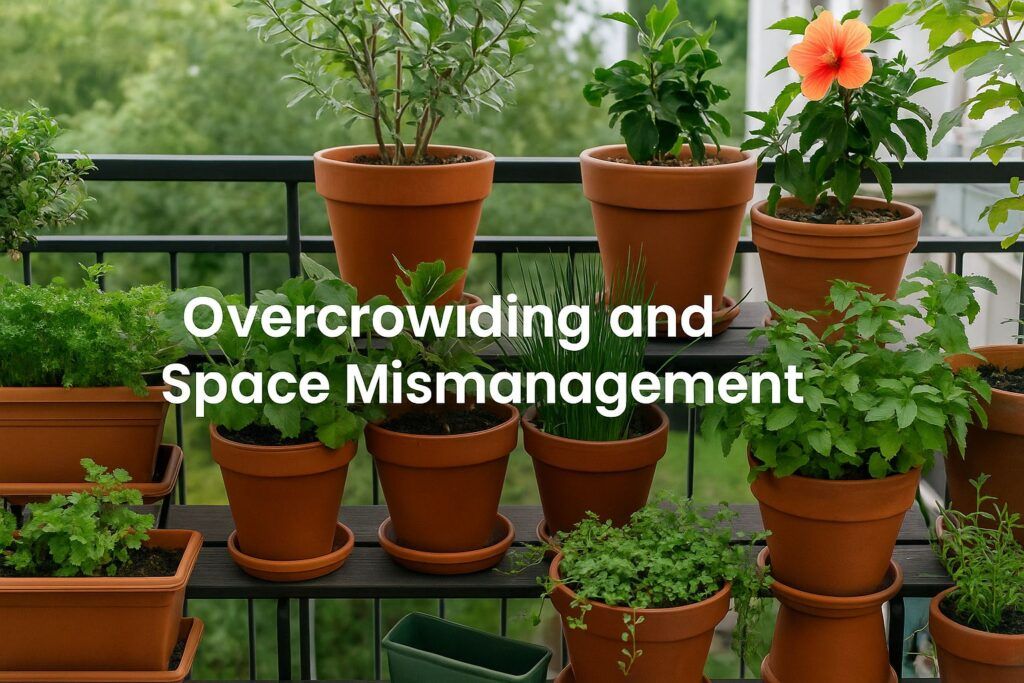
In small urban spaces, the temptation to cram in as many plants as possible is strong. However, overcrowding is one of the most detrimental common mistakes new urban gardeners make, leading to poor growth, disease, and plant failure.
Problems Created by Overcrowding
- Air circulation issues: Poor airflow promotes fungal diseases
- Resource competition: Plants compete for nutrients, water, and light
- Stunted growth: None of the plants reach their full potential
- Pest magnification: Crowded conditions help pests spread rapidly
Proper Spacing Guidelines
Follow seed packet recommendations and consider mature plant size:
- Herbs: 6-12 inches apart depending on variety
- Lettuce: 4-6 inches for loose leaf, 8-12 for head lettuce
- Tomatoes: 18-36 inches apart in separate large containers
- Root vegetables: Follow seed spacing requirements exactly
7. Wrong Timing for Planting
Timing is crucial in gardening, yet many new urban gardeners plant everything at once or ignore seasonal requirements. Understanding when to plant different crops is essential for urban gardening success.
Common Timing Mistakes
- Starting heat-loving plants too early: Cold kills tomatoes and peppers
- Planting cool-season crops in summer: Lettuce bolts in heat
- Not succession planting: Missing continuous harvests
- Ignoring last frost dates: Frost can destroy tender plants overnight
Seasonal Planting Guide
Spring (Cool Season):
Lettuce, spinach, peas, radishes, carrots
Summer (Warm Season):
Tomatoes, peppers, squash, herbs, beans
Fall (Cool Season Return):
Kale, Brussels sprouts, winter lettuce
Winter (Indoor/Protected):
Microgreens, sprouts, indoor herbs
8. Not Preparing for Pests
New urban gardeners often assume they won’t have pest problems, but urban environments can actually have concentrated pest issues. Being unprepared for common garden pests is a costly mistake that can destroy entire crops.
Common Urban Garden Pests
- Aphids: Small, soft-bodied insects that cluster on leaves
- Whiteflies: Tiny flying insects that suck plant juices
- Spider mites: Microscopic pests that create fine webbing
- Fungus gnats: Small flies that thrive in moist potting soil
Organic Pest Prevention
- Inspect plants regularly for early pest detection
- Use companion planting (marigolds, basil, nasturtiums)
- Encourage beneficial insects with diverse plantings
- Apply neem oil spray as preventive measure
- Remove affected plant parts immediately
9. Over-fertilizing or Using Wrong Fertilizers
Many beginners think more fertilizer equals better plants, but over-fertilizing is one of the common mistakes new urban gardeners make that can actually harm plant health and reduce productivity.
Problems with Over-Fertilizing
- Burn roots: High salt concentrations damage plant roots
- Excessive leaf growth: Lots of leaves but no fruit production
- Pest attraction: Soft, lush growth attracts more pests
- Soil imbalance: Disrupts natural soil ecosystem
Proper Fertilizing Approach
- Start with high-quality compost-rich soil
- Use organic, slow-release fertilizers
- Follow package directions – less is often more
- Feed plants based on their specific needs
- Monitor plant response and adjust accordingly
10. Ignoring Weather and Climate Factors
Urban environments create unique microclimates that new gardeners often overlook. Buildings, concrete, and limited air circulation can create much different growing conditions than expected.
Urban Climate Challenges
- Heat island effect: Cities are typically 2-5°F warmer
- Wind tunnels: Buildings can create strong wind corridors
- Reflected heat: Concrete and buildings amplify heat
- Limited air circulation: Reduces natural cooling
Climate Adaptation Strategies
- Use shade cloth during intense heat periods
- Create windbreaks for exposed areas
- Group plants to create beneficial microclimates
- Use mulch to moderate soil temperature
- Move containers to protect from extreme weather
11. Buying Wrong or Poor Quality Tools
Investing in cheap, inappropriate tools might seem like a good way to save money, but poor tools make gardening harder and can damage plants. Having the right tools makes urban gardening much more enjoyable and effective.
Essential Urban Gardening Tools
Must-Have Tools
- Quality hand trowel
- Sharp pruning shears
- Watering can with fine rose
- Hand weeder
- Soil thermometer
Nice-to-Have Tools
- Garden kneeler/seat
- Plant labels and markers
- Spray bottle for misting
- Small rake for containers
- pH testing kit
Tool Buying Tips
- Buy quality tools that will last – they’re more economical long-term
- Choose ergonomic designs to reduce strain
- Consider storage space when selecting tools
- Start with basics and add tools as you gain experience
12. Not Harvesting at the Right Time
Knowing when and how to harvest is crucial for both plant health and food quality. Many new urban gardeners either harvest too early, too late, or not frequently enough, reducing both yield and plant productivity.
Common Harvesting Mistakes
- Waiting too long: Overripe vegetables become tough and bitter
- Harvesting too early: Reduces flavor and nutritional value
- Infrequent harvesting: Signals plants to stop producing
- Improper technique: Damaging plants during harvest
Harvesting Best Practices
- Leafy greens: Harvest outer leaves first, keep center growing
- Herbs: Pinch flowers to keep leaves tender, harvest regularly
- Tomatoes: Pick when color changes but still firm
- Root vegetables: Check size by gently brushing away soil
- General rule: Harvest in morning when plants are fully hydrated
13. Not Monitoring Plants Regularly
Urban gardens require regular attention, but busy lifestyles often lead to neglect. Not checking plants regularly is one of the common mistakes new urban gardeners make that allows small problems to become major disasters.
What to Watch For
- Soil moisture levels: Containers dry out faster than ground soil
- Pest signs: Early detection prevents major infestations
- Disease symptoms: Yellow leaves, spots, or unusual growth
- Growth patterns: Leggy, stunted, or abnormal development
Daily Garden Check Routine
- Quick visual inspection of all plants (2-3 minutes)
- Check soil moisture in a few representative containers
- Look for pest activity on leaf undersides
- Note any changes in plant appearance or growth
- Remove dead or diseased plant material promptly
14. Not Understanding Plant Compatibility
Companion planting and plant compatibility become even more important in small urban spaces. Some plants help each other thrive, while others compete or can actually inhibit each other’s growth.
Good Urban Garden Combinations
Beneficial Pairs
- Tomatoes + Basil
- Lettuce + Radishes
- Carrots + Chives
- Peppers + Marigolds
- Beans + Nasturtiums
Avoid Together
- Tomatoes + Fennel
- Onions + Beans
- Carrots + Dill
- Cucumber + Herbs
- Lettuce + Celery
Companion Planting Benefits
- Natural pest control through beneficial insect attraction
- Efficient use of limited container space
- Improved soil health through diverse root systems
- Enhanced flavor in herbs and vegetables
15. Giving Up Too Early
Perhaps the biggest mistake of all is giving up before giving your garden a real chance to succeed. Urban gardening has a learning curve, and initial setbacks are normal parts of the process.
Why New Gardeners Quit
- Unrealistic expectations: Expecting perfect results immediately
- Single failure mindset: One dead plant feels like total failure
- Comparing to experts: Social media creates unrealistic standards
- Seasonal challenges: Not understanding that gardening changes with seasons
Building Garden Resilience
- Start with easy-to-grow plants to build confidence
- Keep a garden journal to track what works
- Connect with local gardening communities for support
- Celebrate small wins and learn from setbacks
- Remember that every experienced gardener was once a beginner
Quick Reference: Avoiding Common Urban Gardening Mistakes
Before You Start
- Plan your space and assess light conditions
- Choose appropriate container sizes
- Invest in quality soil and drainage
- Start with beginner-friendly plants
Daily Care
- Monitor soil moisture regularly
- Watch for pest and disease signs
- Harvest frequently to encourage growth
- Be patient and learn from mistakes
Frequently Asked Questions About Urban Gardening Mistakes
What is the most common mistake new urban gardeners make?
The most common mistake is starting without proper planning. New urban gardeners often rush to buy plants and containers without assessing their space, light conditions, or understanding plant requirements. This leads to poor plant selection, inappropriate container sizes, and ultimately, garden failure.
Why do my container plants keep dying despite regular watering?
Overwatering is often the culprit, not underwatering. Common causes include containers without drainage holes, using regular garden soil that retains too much moisture, or watering on a schedule rather than checking soil moisture. Always ensure proper drainage and water only when the top inch of soil feels dry.
How can I tell if my urban garden containers are too small?
Signs of containers that are too small include: plants drying out very quickly, stunted growth despite good care, roots growing out of drainage holes, plants that fall over easily, and yellowing leaves despite proper fertilizing. Most vegetables need containers at least 12-18 inches deep.
What vegetables are best for beginner urban gardeners?
Start with fast-growing, forgiving crops like lettuce, spinach, radishes, herbs (basil, parsley, cilantro), and green onions. These plants are tolerant of beginner mistakes, grow quickly for fast rewards, and don’t require large containers. Avoid starting with tomatoes or peppers until you gain experience.
How do I know if my balcony gets enough sunlight for vegetables?
Track sunlight for a full day by checking hourly from sunrise to sunset. Most vegetables need 6+ hours of direct sunlight. If you get 4-6 hours, grow leafy greens and herbs. With less than 4 hours, focus on shade-tolerant plants like lettuce, spinach, and mint. Remember that sunlight patterns change with seasons.
Should I use regular potting soil or make my own mix for urban containers?
High-quality commercial potting mixes work well, but avoid cheap ones that are mostly peat or bark. For better results, enhance store-bought potting soil by adding 20-30% compost and some perlite for drainage. Never use regular garden soil in containers as it compacts and drains poorly.
How often should I check my urban garden for problems?
Check your plants daily, even if just for 2-3 minutes. Look for changes in leaf color, signs of pests, soil moisture levels, and overall plant health. Daily monitoring allows you to catch problems early when they’re easier to fix. Container plants change more rapidly than ground plants, making regular observation crucial.
Your Path to Urban Gardening Success
Understanding these common mistakes new urban gardeners make puts you ahead of most beginners. Urban gardening success isn’t about having a green thumb—it’s about avoiding predictable pitfalls and learning from each growing season.
Remember that every experienced urban gardener once made these same mistakes. The key is to start small, learn systematically, and enjoy the process of growing your own food in the city. Your tiny balcony or rooftop can become a productive source of fresh vegetables and herbs with the right approach.
Ready to Start Your Urban Garden?
Begin with just 2-3 of the easiest plants mentioned in this guide. Focus on getting those thriving before expanding. Most importantly, don’t let the fear of making mistakes prevent you from starting—every mistake is a learning opportunity that makes you a better gardener.
Happy gardening! Your future self will thank you for every mistake you learn from today.
This guide covers the most common mistakes new urban gardeners make based on expert research and practical experience.
